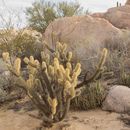fr
noms dans le fil d’Ariane


Cylindropuntia ganderi ist eine Pflanzenart aus der Gattung Cylindropuntia in der Familie der Kakteengewächse (Cactaceae). Das Artepitheton ehrt Frank F. Gander.[1] Ein Trivialname ist „Gander’s Cholla“.
Cylindropuntia ganderi wächst strauchig mit stets aufwärts gebogenen Zweigen und erreicht Wuchshöhen von 0,5 bis 1,5 Meter. Auf den fest haftenden, grünen, 5 bis 20 Zentimeter langen und 1,7 bis 4,5 Zentimeter im Durchmesser messenden Triebabschnitten befinden sich etwas zu Rippen zusammenfließende Höcker. Die gelb bis lohfarben bewollten Areolen vergrauen im Alter und tragen 0,5 bis 6 Millimeter lange gelbe bis rostfarbene Glochiden. Die 11 bis 28 Dornen sind an fast allen Areolen vorhanden und verdecken die Triebe etwas. Sie sind ausgebreitet bis aufrecht, im Querschnitt kreisrund oder abgeflacht, weiß bis rötlich und werden im Alter dunkler. Die Dornen sind 2 bis 3,5 Zentimeter lang. Die lose sitzenden Scheiden der Dornen sind weiß bis gelb.
Die Blüten sind grünlich gelb. Die kugelförmigen, klettenartigen, anfangs gelblichen Früchte sind trocken lohfarben.
Cylindropuntia ganderi ist in den Vereinigten Staaten im Bundesstaat Kalifornien sowie im mexikanischen Bundesstaat Baja California in Höhenlagen von 100 bis 1000 Metern verbreitet
Die Erstbeschreibung als Opuntia acanthocarpa subsp. ganderi von Carl Brandt Wolf wurde 1938 veröffentlicht.[2] Jon Paul Rebman und Donald John Pinkava erhoben die Unterart 2001 in den Rang einer eigenständigen Art.[3] Weitere nomenklatorische Synonyme sind Opuntia acanthocarpa var. ganderi (C.B.Wolf) L.D.Benson (1969), Opuntia ganderi (C.B.Wolf) Rebman & Pinkavav (1996) und Grusonia ganderi (C.B.Wolf) G.D.Rowley (2006).
Es werden folgende Unterarten unterschieden:[4]
In der Roten Liste gefährdeter Arten der IUCN wird die Art als „Least Concern (LC)“, d. h. als nicht gefährdet geführt. Die Entwicklung der Populationen wird als stabil angesehen.[5]
Cylindropuntia ganderi ist eine Pflanzenart aus der Gattung Cylindropuntia in der Familie der Kakteengewächse (Cactaceae). Das Artepitheton ehrt Frank F. Gander. Ein Trivialname ist „Gander’s Cholla“.
Cylindropuntia ganderi, also known as Gander cholla and Gander's buckhorn cholla, is a cholla native to the Sonoran desert of Baja California, Mexico, and the adjacent border area of southern California, US where it intergrades with Cylindropuntia californica.[1]
Cylindropuntia ganderi, also known as Gander cholla and Gander's buckhorn cholla, is a cholla native to the Sonoran desert of Baja California, Mexico, and the adjacent border area of southern California, US where it intergrades with Cylindropuntia californica.
Cylindropuntia ganderi es una especie de choya de la familia Cactaceae que se distribuye en Baja California en México y California en Estados Unidos. La palabra ganderi es un epíteto en honor a Frank F. Gander, zoólogo y botánico, curador del Museo de Historia Natural de San Diego.[2][3]
Tiene crecimiento arbustivo, ramificada desde la base, con tallos ascendentes de hasta 1.5 m de alto. Las ramificaciones terminales de 5 a 20 cm de largo y 2 a 4 cm de ancho con tubérculos acostillados. Las areolas son elípticas de color amarillo a gris Tiene de 11 a 28 espinas en la mayoría de sus areolas, de color blanco a rojizo y 3 cm de largo. La flor de color amarillo verdoso. El fruto que produce es globoso, amarillento y pardo cuando se seca.[4][5]
Se distribuye en Baja California en México y en el sur de California en Estados Unidos. Habita matorrales xerófilos y bosques de encino (Quercus) sobre planicies aluviales en sustratos de arena o roca. En elevaciones de 100 a 1000 msnm.[1]
No se conocen amenazas para su conservación, es una especie relativamente común y su área de distribución es amplia. Se puede encontrar en área protegidas como el Parque Estatal del Desierto de Anza-Borreo, el parque nacional Sierra de San Pedro Mártir y la Reserva de la Biosfera El Vizcaíno.[1]
Cylindropuntia ganderi es una especie de choya de la familia Cactaceae que se distribuye en Baja California en México y California en Estados Unidos. La palabra ganderi es un epíteto en honor a Frank F. Gander, zoólogo y botánico, curador del Museo de Historia Natural de San Diego.
Cylindropuntia ganderi là một loài thực vật có hoa trong họ Cactaceae. Loài này được (C.B.Wolf) Rebman & Pinkava mô tả khoa học đầu tiên năm 2001.[1]
Cylindropuntia ganderi là một loài thực vật có hoa trong họ Cactaceae. Loài này được (C.B.Wolf) Rebman & Pinkava mô tả khoa học đầu tiên năm 2001.